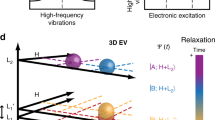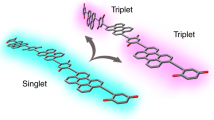Abstract
Nuclear–electronic (vibronic) coupling is increasingly recognized as a mechanism of major importance in controlling the light-induced function of molecular systems. It was recently shown that infrared light excitation of intramolecular vibrations can radically change the efficiency of electron transfer, a fundamental chemical process. We now extend and generalize the understanding of this phenomenon by probing and perturbing vibronic coupling in several molecules in solution. In the experiments an ultrafast electronic–vibrational pulse sequence is applied to a range of donor–bridge–acceptor Pt(II) trans-acetylide assemblies, for which infrared excitation of selected bridge vibrations during ultraviolet-initiated charge separation alters the yields of light-induced product states. The experiments, augmented by quantum chemical calculations, reveal a complex combination of vibronic mechanisms responsible for the observed changes in electron transfer rates and pathways. The study raises new fundamental questions about the function of vibrational processes immediately following charge transfer photoexcitation, and highlights the molecular features necessary for external vibronic control of excited-state processes.
This is a preview of subscription content, access via your institution
Access options
Subscribe to this journal
Receive 12 print issues and online access
$259.00 per year
only $21.58 per issue
Buy this article
- Purchase on Springer Link
- Instant access to full article PDF
Prices may be subject to local taxes which are calculated during checkout





Similar content being viewed by others
References
Balzani, V. Electron Transfer in Chemistry (Wiley-VCH, 2001).
Schrauben, J. N., Dillman, K. L., Beck, W. F. & McCusker, J. K. Vibrational coherence in the excited state dynamics of Cr(acac)3: probing the reaction coordinate for ultrafast intersystem crossing. Chem. Sci. 1, 405–410 (2010).
Damrauer, N. et al. Femtosecond dynamics of excited-state evolution in [Ru(bpy)3]2+. Science 275, 54–57 (1997).
Cannizzo, A. et al. Femtosecond fluorescence and intersystem crossing in rhenium(I) carbonyl–bipyridine complexes. J. Am. Chem. Soc. 130, 8967–8974 (2008).
Barbara, P. F., Meyer, T. J. & Ratner, M. A. Contemporary issues in electron transfer research. J. Phys. Chem. 100, 13148–13168 (1996).
Vlcek, A. The life and times of excited states of organometallic and coordination compounds. Coord. Chem. Rev. 200–202, 933–977 (2000).
Roberts, G. M. et al. Exploring quantum phenomena and vibrational control in σ* mediated photochemistry. Chem. Sci. 4, 993–1001 (2013).
Shapiro, M. & Brumer, P. Coherent control of molecular dynamics. Rep. Prog. Phys. 66, 859–942 (2003).
Prokhorenko, V. I. et al. Coherent control of retinal isomerization in bacteriorhodopsin. Science 313, 1257–1261 (2006).
Conyard, J. et al. Ultrafast dynamics in the power stroke of a molecular rotary motor. Nature Chem. 4, 547–551 (2012).
Davis, D., Toroker, M. C., Speiser, S. & Peskin, U. On the effect of nuclear bridge modes on donor–acceptor electronic coupling in donor–bridge–acceptor molecules. Chem. Phys. 358, 45–51 (2009).
Soler, M. A., Nelson, T., Roitberg, A. E., Tretiak, S. & Fernandez-Alberti, S. Signature of nonadiabatic coupling in excited-state vibrational modes. J. Phys. Chem. A 118, 10372–10379 (2014).
Skourtis, S. S., Waldeck, D. H. & Beratan, D. N. Inelastic electron tunneling erases coupling-pathway interferences. J. Phys. Chem. B 108, 15511–15518 (2004).
Xiao, D., Skourtis, S. S., Rubtsov, I. V. & Beratan, D. N. Turning charge transfer on and off in a molecular interferometer with vibronic pathways. Nano Lett. 9, 1818–1823 (2009).
Beratan, D. N. et al. Steering electrons on moving pathways. Acc. Chem. Res. 42, 1669–1678 (2009).
Antoniou, P., Ma, Z., Zhang, P., Beratan, D. N. & Skourtis, S. S. Vibrational control of electron transfer reactions: a feasibility study for the fast coherent transfer regime. Phys. Chem. Chem. Phys. http:dx.doi.org/10.1039/C5CP00610D (2015).
Elsaesser, T. & Kaiser, W. Vibrational and vibronic relaxation of large polyatomic molecules in liquids. Annu. Rev. Phys. Chem. 42, 83–107 (1991).
Briney, K. A., Herman, L., Boucher, D. S., Dunkelberger, A. D. & Crim, F. F. The influence of vibrational excitation on the photoisomerization of trans-stilbene in solution. J. Phys. Chem. A 114, 9788–9794 (2010).
Kasyanenko, V. M., Lin, Z., Rubtsov, G. I., Donahue, J. P. & Rubtsov, I. V. Energy transport via coordination bonds. J. Chem. Phys. 131, 154508 (2009).
Delor, M. et al. Dynamics of ground and excited state vibrational relaxation and energy transfer in transition metal carbonyls. J. Phys. Chem. B 118, 11781–11791 (2014).
Park, K.-H. et al. Infrared probes based on nitrile-derivatized prolines: thermal insulation effect and enhanced dynamic range. J. Phys. Chem. Lett. 4, 2105–2110 (2013).
Spears, K. G., Wen, X. & Zhang, R. Electron transfer rates from vibrational quantum states. J. Phys. Chem. 100, 10206–10209 (1996).
Huang, Y., Rettner, C. T., Auerbach, D. J. & Wodtke, A. M. Vibrational promotion of electron transfer. Science 290, 111–114 (2000).
Yue, Y. et al. Electron transfer rate modulation in a compact Re(I) donor–acceptor complex. Dalton Trans. 44, 8609–8616 (2015).
Lin, Z. et al. Modulating unimolecular charge transfer by exciting bridge vibrations. J. Am. Chem. Soc. 131, 18060–18062 (2009).
Delor, M. et al. Toward control of electron transfer in donor–acceptor molecules by bond-specific infrared excitation. Science 346, 1492–1495 (2014).
Scattergood, P. A. et al. Electron transfer dynamics and excited state branching in a charge-transfer platinum(II) donor–bridge–acceptor assembly. Dalton Trans. 43, 17677–17693 (2014).
Kwok, W. M., Phillips, D. L., Yeung, P. K. & Yam, V. W. Resonance Raman investigation of the MLCT transition in [Pt(dppm)2(PhCtC)2] and the MMLCT transition in [Pt2(µ-dppm)2(µ-PhCtC)(PhCtC)2]+. J. Phys. Chem. A 101, 9286–9295 (1997).
Delor, M., Sazanovich, I. V., Towrie, M. & Weinstein, J. A. Probing and exploiting the interplay between nuclear and electronic motion in charge transfer processes. Acc. Chem. Res. 48, 1131–1139 (2015).
Bertoni, R. et al. Ultrafast light-induced spin-state trapping photophysics investigated in Fe(phen)2(NCS)2 spin-crossover crystal. Acc. Chem. Res. 48, 774–781 (2015).
Schnedermann, C., Liebel, M. & Kukura, P. Mode-specificity of vibrationally coherent internal conversion in rhodopsin during the primary visual event. J. Am. Chem. Soc. 137, 2886–2891 (2015).
Hamm, P. & Zanni, M. Concepts and Methods of 2D Infrared Spectroscopy (Cambridge Univ. Press, 2011).
Anna, J. M., Baiz, C. R., Ross, M. R., McCanne, R. & Kubarych, K. J. Ultrafast equilibrium and non-equilibrium chemical reaction dynamics probed with multidimensional infrared spectroscopy. Int. Rev. Phys. Chem. 31, 367–419 (2012).
Parmenter, S. Vibrational redistribution within excited electronic states of polyatomic molecules. Faraday Discuss. Chem. Soc. 75, 7–22 (1983).
Horng, M. L., Gardecki, J. A., Papazyan, A. & Maroncelli, M. Subpicosecond measurements of polar solvation dynamics: coumarin 153 revisited. J. Phys. Chem. 99, 17311–17337 (1995).
Bräm, O., Messina, F., El-Zohry, A. M., Cannizzo, A. & Chergui, M. Polychromatic femtosecond fluorescence studies of metal–polypyridine complexes in solution. Chem. Phys. 393, 51–57 (2012).
Chergui, M. Ultrafast photophysics of transition metal complexes. Acc. Chem. Res. 48, 801–808 (2015).
Fuller, F. D. et al. Vibronic coherence in oxygenic photosynthesis. Nature Chem. 6, 1–6 (2014).
Romero, E. et al. Quantum coherence in photosynthesis for efficient solar-energy conversion. Nature Phys. 10, 676–682 (2014).
Sukegawa, J. et al. Electron transfer through rigid organic molecular wires enhanced by electronic and electron–vibration coupling. Nature Chem. 6, 899–905 (2014).
Bakulin, A. A. et al. The role of driving energy and delocalized states for charge separation in organic semiconductors. Science 335, 1340–1344 (2012).
Greetham, G. et al. ULTRA: a unique instrument for time-resolved spectroscopy. Appl. Spectrosc. 64, 1311–1319 (2010).
Snellenburg, J. J., Laptenok, S. P., Seger, R., Mullen, K. M. & van Stokkum, I. H. M. Glotaran: a Java-based graphical user interface for the R package TIMP. J. Stat. Softw. 49, 1–22 (2012).
Becke, A. D. Density-functional thermochemistry. III. The role of exact exchange. J. Chem. Phys. 98, 5648–5652 (1993).
Lee, C., Yang, W. & Parr, R. G. Development of the Colle–Salvetti correlation-energy formula into a functional of the electron density. Phys. Rev. B 37, 785–789 (1988).
Dunning, T. H. Jr . Gaussian basis sets for use in correlated molecular calculations. I. The atoms boron through neon and hydrogen. J. Chem. Phys. 90, 1007–1023 (1989).
Dunning, T. H. Jr, Peterson, K. A. & Wilson, A. K. Gaussian basis sets for use in correlated molecular calculations. X. The atoms aluminum through argon revisited. J. Chem. Phys. 114, 9244–9253 (2001).
Figgen, D., Peterson, K. A., Dolg, M. & Stoll, H. Energy-consistent pseudopotentials and correlation consistent basis sets for the 5d elements Hf–Pt. J. Chem. Phys. 130, 164108 (2009).
Frisch, M. J. et al. Gaussian 09, Revision D.01. (Gaussian, 2013).
Mennucci, B. & Tomasi, J. Continuum solvation models: a new approach to the problem of solute's charge distribution and cavity boundaries. J. Chem. Phys. 106, 5151–5158 (1997).
Acknowledgements
The authors thank A. Parker and A. Vlcek for discussions. The authors acknowledge the support of the Engineering and Physical Sciences Research Council (EPSRC), the University of Sheffield and the Science and Technology Facilities Council (STFC). Calculations were performed on the local ‘Jupiter’ cluster of the Theoretical Chemistry Group and the central ‘Iceberg’ cluster of the University of Sheffield. A licence for the OpenEye tools was obtained via the free academic licensing programme.
Author information
Authors and Affiliations
Contributions
M.D. and J.A.W. conceived and designed the experiments. M.D., I.V.S. and J.A.W. conducted the experiments on a set-up built and operated by M.T., G.M.G. and I.V.S. M.D. analysed the experimental data. P.A.S. synthesized the molecules. T.K. and A.J.H.M.M. devised, performed and analysed the DFT calculations and considered their correspondence to experimental data. M.D. and J.A.W. wrote the paper, with input from all authors.
Corresponding authors
Ethics declarations
Competing interests
The authors declare no competing financial interests.
Supplementary information
Supplementary information
Supplementary information (PDF 1679 kb)
Rights and permissions
About this article
Cite this article
Delor, M., Keane, T., Scattergood, P. et al. On the mechanism of vibrational control of light-induced charge transfer in donor–bridge–acceptor assemblies. Nature Chem 7, 689–695 (2015). https://doi.org/10.1038/nchem.2327
Received:
Accepted:
Published:
Issue Date:
DOI: https://doi.org/10.1038/nchem.2327
This article is cited by
-
A framework for multiexcitonic logic
Nature Reviews Chemistry (2024)
-
Ultrafast vibrational control of organohalide perovskite optoelectronic devices using vibrationally promoted electronic resonance
Nature Materials (2024)
-
Insight into solvent-polarity-regulated photoinduced excited state behaviors for E-HBT fluorophore: a theoretical investigation
Theoretical Chemistry Accounts (2024)
-
Solvent tuning of photochemistry upon excited-state symmetry breaking
Nature Communications (2020)
-
Evidence for a vibrational phase-dependent isotope effect on the photochemistry of vision
Nature Chemistry (2018)



